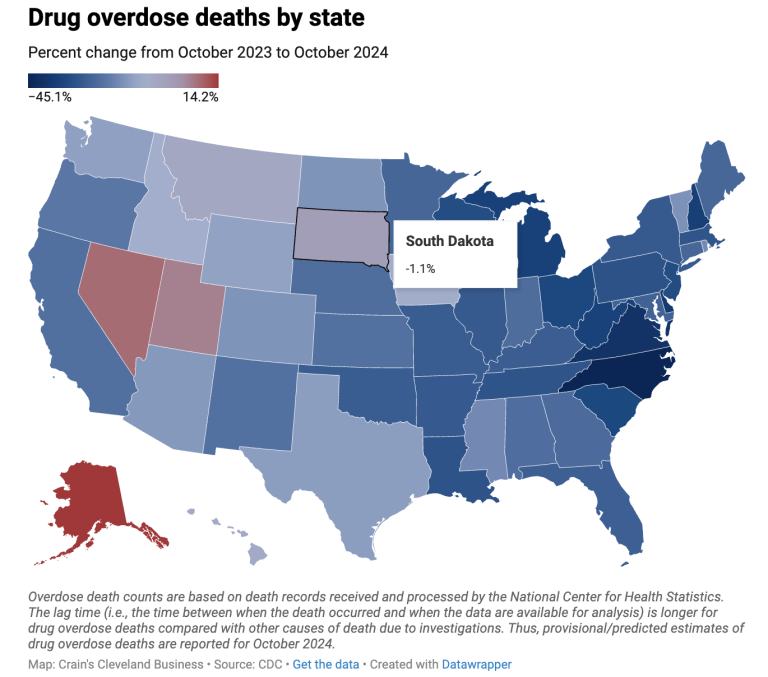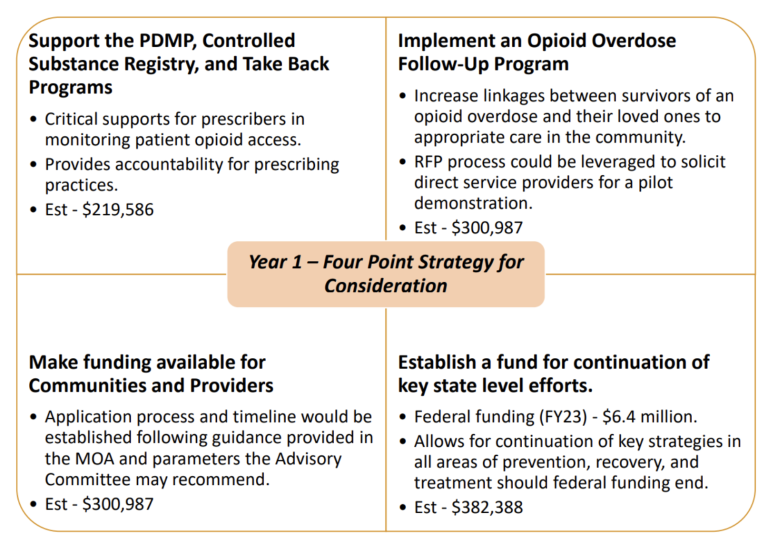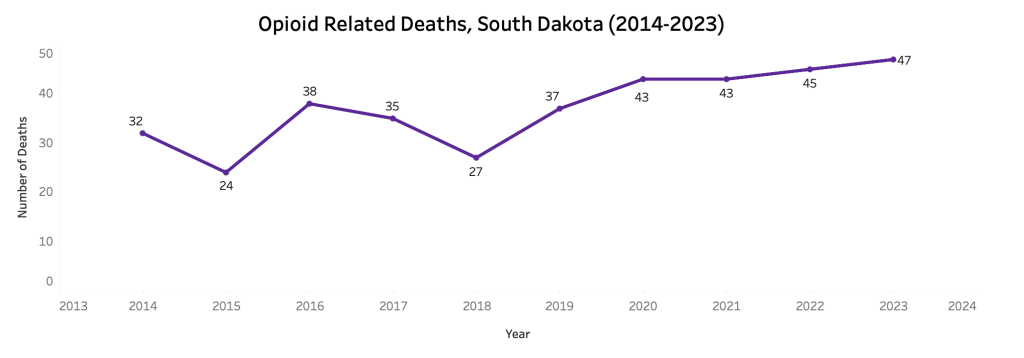WITH NO EFFECTIVE NALOXONE RESPONSE, SOUTH DAKOTA ANOTHER REVELATORY LETHAL EXCEPTION TO DRAMATIC U.S. DROP IN OPIOID OVERDOSE DEATHS
As in San Francisco, Nevada, Tennessee, Utah and Washington: lack or delay of effective naloxone campaigns to reduce harm due to expert treatments predicts OD death trends
by Clark Miller
Published May 23, 2025
For South Dakota it nearly seems plausible to posit a mystery shrouding the opioid crisis – not for the overdose and fatality trends, as we’ll soon see – for the distorting haze surrounding state, institutional and public health responses, or failure of, while intensive, effective naloxone campaigns dropped, often dramatically, opioid overdose deaths in nearly every other state.
“Why Wait?” one headline seemed to scream, the news piece describing legislative changes required so that, not until July of 2023, bystanders could obtain and carry the opioid fatal overdose reversing drug.
No, really. July, 2023.
Bystanders who witness an opioid overdose in a public space, restaurant or workplace only have one option under existing state law: call 911 and wait for help to arrive.
But waiting puts lives at risk, said Rep. Brian Mulder, R-Sioux Falls.
Under current law, medications used to treat opioid overdoses in emergency situations — such as naloxone, often delivered as Narcan nasal spray — are only able to be purchased and carried by first responders, nurses and people who know someone at risk of overdose.
That will change on July 1.
That’s not a bad thing, it’s just, as in some other locales (like here and here and here) a really late thing, lethally late, while “Opioid-related deaths continue to grow in South Dakota and have doubled from 21 to 43 in the last decade.”

Unlike what appears to be nearly all other states, South Dakota is just not feeling this naloxone thing.
In 2023 the state Department of Health was updating its opioid awareness materials to provide public awareness of the availability of Narcan. In 2023.
Health system Avera Health had no plans at that time to promote awareness of Narcan’s availability, nor did the Sioux Falls Chamber of Commerce. Psychiatrist Matt Stanley downplayed the distribution of naloxone and emphasized that employers can choose to not have it on hand.
The state Department of Health is redeveloping training for the public, and the “Avoid Opioid” media campaign will be updated to include awareness about the availability of Narcan and how it works, said Director of the Division of Healthcare Access Emily Kiel.
“Our department and the Department of Social Services are collaborating to promote and improve access to naloxone across South Dakota,” Kiel wrote in an emailed statement. “True to the recent legislation, these efforts will increase for targeted populations, including employers.”
Avera does not have any intentions to spread awareness about the bill to South Dakota employers, and the Greater Sioux Falls Chamber of Commerce also does not plan to give word to its members, said Jennie Doyen, chamber vice president of member services.
Stanley said it isn’t necessary that opioid antagonists are everywhere or that every employer takes advantage of the law. He said the beauty of the bill is that it isn’t a mandate, so employers decide what their employees and customers need.
Also reported in 2023, the state received that year $3.5 million in opioid settlement funds.
Among cities and counties, plans included:
“education campaigns to discourage illicit drug use”
“relying on local law enforcement to decide how best to use the funds”
“community triage center providing sobering, addiction and crisis stabilization services”
“drug use prevention programming and education as well as treatment services”
“$85,000 to hire a substance abuse counselor for its jail and increase counselor training for the drug and alcohol Care Campus”
“Rapid City appointed its police department to designate how to use the money”
“expand the police department’s evidence laboratory testing to include drug purity testing”
“education programming and supporting a community resource officer”
“putting the money toward a drug court program”
“distributing funds to local intervention and treatment services”
“giving the money to local school districts to fund prevention efforts”
The state described it’s plans for use of an initial $ 1.2 million.
The plan establishes a fund for communities and providers to apply for grants; establishes a fund for continued state efforts in prevention, recovery and treatment; supports the state prescription drug monitoring program to ensure opioids are not being over-prescribed; and creates an opioid overdose follow-up program.
The goal of the follow-up program is to increase links between survivors of opioid overdoses and community care. The state DSS will start accepting proposals for organizations interested in partnering for the program, said state DSS Secretary Matt Althoff in an emailed statement.

Nowhere in that report of state and local plans for settlement money is naloxone – not support for free provision and distribution, not for trainings, not for targeted community distribution of the type that has dramatically reduced fatal opioid ODs in other states.
Lacking that support, it’s been falling on the non-profit “Emily’s Hope” to get Narcan where it’s needed, the frustration and urgency coming through in a report as recent as May, 2024.
“Anybody can just pick up Narcan and we encourage everyone to carry it,” Emily’s Hope Founder and CEO Angela Kennecke said. “It is not just for people who use illicit drugs to carry. It is for everyone to carry. There have been overdoses and people saved in grocery store bathrooms, in the middle of traffic, all kinds of places, so it is a good idea.”
“I feel like I’m just shouting from the rooftops about this issue, trying to save lives,” Kennecke said. “This epidemic just keeps getting worse and worse. Fentanyl is now the number one killer of people ages 18 to 45,” Emily’s Hope founder Angela Kennecke said.
And as recently as in this April 2025 report, a heightened sense of progress comes from setting up a few naloxone boxes in South Dakota communities.
That’s a good thing, and late, lethally late as in other locations that have been exceptions to the rule – the nearly consistent trend of recent, dramatic drops in fatal opioid overdose deaths attributable entirely to intensive, targeted, successful naloxone campaigns begun years ago.
They are exceptions that prove the rule.
South Dakota has not lagged in reduction of opioid-related deaths because it is a west coast state, or affected by some cultural or psychosocial unseen force affecting compulsive drug users and rolling across the U.S. from east to west coasts, or due to any other benighted, evidence-free rationalization needed to distract from lethal truths.
Instead it fits the universal pattern: late to implement the desperate, targeted, effective emergency naloxone campaigns made necessary by the failure of expert gold standard treatments to reduce persistently surging high-risk opioid use.
Lethally late.
But not late to reduce safety standards to allow less controlled medical dispensing of the opioids established as fueling the crisis and persistent high-risk opioid use.










